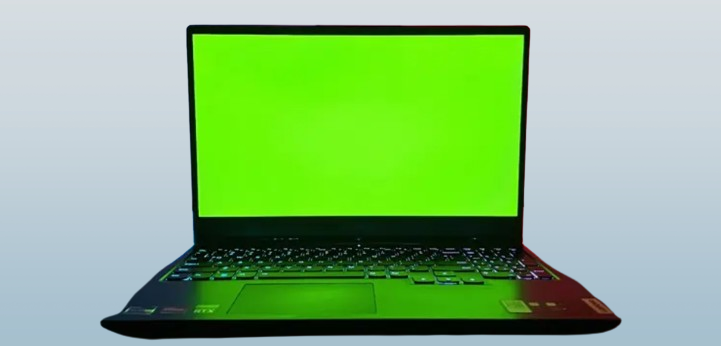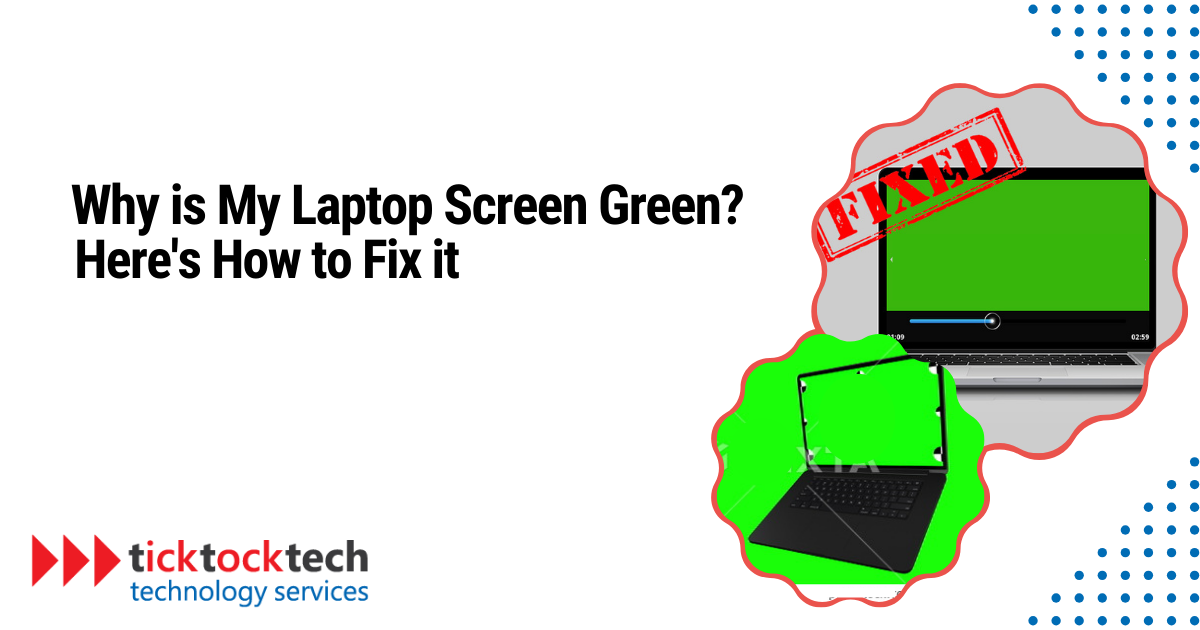Is your laptop screen displaying an unexpected shade of green either at startup or randomly while in use? Perhaps you’re seeing a solid green screen or green patches appearing amidst your usual display. Either way, it’s obvious something isn’t right, but don’t worry – we’re here to help you understand and fix the issue.
What is the Green Screen of Death?
Green Screen of Death (GSOD) is derived from the infamous Blue Screen of Death (BSOD) Windows users might be familiar with. The Green Screen of Death occurs when your laptop screen turns green, sometimes accompanied by an error message. The screen might also freeze, causing your laptop to become unresponsive.
Unlike the BSOD, which typically indicates a critical system failure or hardware malfunction, a green screen on a laptop signifies a graphics-related problem. It is often caused by issues with the graphics hardware, drivers, or display connections.
When a laptop experiences the Green Screen of Death, it can manifest in different ways. In some cases, the entire screen may be covered with a solid block of green, making it impossible to see the actual content. In other instances, green patches or lines may appear, while the rest of the display remains visible.
While the green screen is not as alarming as the BSOD, it can still be frustrating. It affects your ability to view files and media documents accurately. However, the good news is that in most cases, the green screen issue can be resolved with a few troubleshooting steps.
In the following sections, we will explore the common causes of the green screen problem on a laptop and step-by-step solutions to help you fix it.
What happens when your Screen turns Green?
When your screen turns green, it’s because the display adapter or graphics card is malfunctioning. When your laptop screen turns green, it means that there is an issue with the graphics display. It can appear as a completely green screen or a green tint covering the entire display.

In some cases, the green screen can be caused by a virus or malware infection. So, it’s crucial to run a virus scan to be sure your operating system is up-to-date before trying to fix the issue.
Why your Laptop Screen is Green
Now that we’ve established what happens when your screen turns green, let’s take a look at some of the common reasons why it’s happening in the first place:
- Loose or Faulty Display Cable: One possible cause is an improper connection between your laptop’s screen and the motherboard. A loose or faulty display cable can result in distorted colors.
- Outdated or Corrupt Graphics Drivers: Graphics drivers play a crucial role in rendering images on your laptop screen. Outdated or corrupt drivers can cause display abnormalities, including the green screen problem.
- Incorrect Color Settings: Sometimes, incorrect color settings can cause your screen to appear green. You can adjust color settings on your laptop to recalibrate the colors.
- Hardware Issues: In some cases, hardware problems can contribute to a green screen. A faulty graphics processing unit (GPU) can cause display abnormalities.
How to fix the Green Screen on your Laptop
Now that you know the reasons behind your laptop’s green screen, let’s take a look at the necessary troubleshooting steps to fix it:
1. Check Cable Connection
The first step is to check the cable connection between your laptop and external monitor. If the monitor works properly, there might be an issue with your laptop’s display cable or panel. In this case, you need to replace the cable or panel. If you’re confident in doing it yourself, follow these steps:
- Remove the external battery and power cables.
- Unscrew the back panel and take it off using a prying tool.
- Disconnect all internal batteries.
- Look for the display cable and gently pull it off.
- Reinsert the cable while ensuring proper connection.
- Reconnect the batteries and put back the case.
- Power up the laptop and check if the issue persists.
If the green screen still appears, you may need to replace the display panel. To do this, follow the same steps as above, but this time, remove the bezel and unscrew the panel on all sides. Then, remove the panel and lay it face downwards. Disconnect the display cable and reconnect it in a similar way to the previous step.
2. Update or Reinstall Graphics Drivers
Another possible cause of a green screen is faulty graphics drivers. If you’ve recently updated your system or made changes to the graphics settings, it might have caused the issue. To fix this, you need to update or reinstall your graphics drivers. Here’s how:
- Restart your laptop and press the BIOS key to enter BIOS Settings.
- Search for Onboard Graphics or a similar setting and enable it.
- Set the Primary Display to IGP or IGFX.
- Boot to your operating system and log in to your user account.
- Open Run by pressing Win + R and type devmgmt.msc.
- Expand Display Adapters and right-click on your dedicated GPU.
- Select Update driver and then Search automatically for drivers.
3. Change Color Calibration
If your display shows a uniform tint of green after your system loads the welcome screen, it indicates a color balance issue. You can fix this by recalibrating your display. Here’s how:
- Open Run by pressing Win + R and type colorcpl.
- Press Enter to open Color Management.
- Go to the Advanced tab and click on Calibrate display.
- Follow the on-screen instructions.
- On the color balance page, make sure that all the sliders (Red, Green, and Blue) are set to the maximum value.
- Follow the rest of the instructions accordingly.
4. Repair or Replace GPU
If none of the above solutions work, your GPU is likely damaged. Unfortunately, a laptop’s GPU is not easily detachable, so we highly recommend seeking help from a reliable computer repair service.
Frequently Asked Questions
Conclusion
The green screen on a laptop is caused by issues with the graphics hardware, drivers, display connections, or incorrect color settings. It can be fixed by checking cable connections, updating or reinstalling graphics drivers, adjusting color settings, or recalibrating the display. However, if the problem persists, TickTockTech Tech Support is available 24/7, reach out for help by dialing (888) 958-7032.

